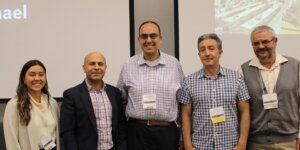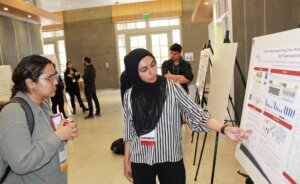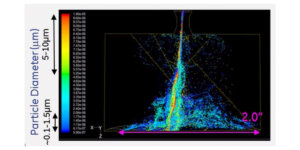
Panelists at the USC + Amazon Center on Trustworthy AI’s Third Annual Symposium on April 30, 2024: moderator Angelica Weiner, Salman Avestimehr, Rajiv Dhawan, Aram Galstyan and Daniel Marcu. (USC Photo/Landon Hall)
At the conclusion of the USC + Amazon Center on Trustworthy AI’s third annual symposium, the message was simple: Industry and academia have to keep collaborating to solve the world’s pressing problems.
“Talk to one another,” Rajiv Dhawan, who leads the Academic Partnerships Group within Amazon’s Artificial General Intelligence Group. “Meet and talk about science, and riff on it.”
The Center launched in 2021, before the rise of ChatGPT and other large language models (LLMs) powered by artificial intelligence. The center’s aim is to bring together researchers from the company and USC to focus on machine (ML) learning privacy, security and trustworthiness. Those themes echoed at the symposium on April 30. Daniel Marcu, VP of AGI — Web & Knowledge Services at Amazon, said the trustworthiness of AI is more important than ever. During a panel discussion titled “Working With Industry,” Marcu challenged engineers working on new projects: “Is what you’re doing useful? Is it improving the way people live in any meaningful way?”
The overall sentiment of the gathering at the Michelson Center for Convergent Bioscience was interdisciplinary cooperation. Recent years have seen a growing spirit of collaboration between Amazon and other high-tech companies and universities. Once upon a time, the walls between those institutions were less permeable, but that has changed. Dhawan said what the company is looking for in talent are people with big ideas: “to have our most challenging problems addressed, and to build community.”
Salman Avestimhehr, a Dean’s Professor of Electrical and Computer Engineering and the inaugural director of the USC + Amazon Center, recalled an instance of industry and academic researchers working together. It taught him the folly of choosing a problem too soon. He worked on an exciting research project with Intel, Cisco and Verizon, aimed at improving wifi bandwidth for video aboard jetliners.
“Whenever I talk to industry folks, they have tons of problems,” he said. “A large fraction of them are going to be marginal. So, if we rush in and choose the wrong ones, then it becomes a painful problem where there is not much room for research innovation. Spending more time is good. Getting to know each other. Maybe two months. Then pick the right problem. Verizon mentioned a problem. It turned out to be such a beautiful problem, we worked on it for five years.”
The panel was moderated by Amazon’s Angelica Weiner and also included Aram Galstyan, a research professor of computer science and a principal scientist at the USC Information Sciences Institute.

Erum Mushtaq explains her research during the poster-display session at the USC + Amazon Center Symposium.
The symposium featured presentations on the research projects announced at the Center’s kickoff meeting last October. There was also a poster competition, and three students’ work was singled out: Elizabeth Ondula, Erum Mushtaq and Lucine Oganesian.
Ondula’s paper is titled “Sentimental Agents: Combining Sentiment Analysis and Non-Bayesian Updating for Cooperative Decision-Making.”
Mushtaq’s paper is titled “Cro-Mo Mixup: Augmenting Cross-Model Representations for Continual Self-Supervised Learning.”
Oganesian’s paper is titled “Modeling Intracranial Neural Recordings in Low-Label Data Regimes Using Self-Supervised Contrastive Learning.” The goal of the work is to “develop machine learning tools for learning models of intracranial brain activity to decode internal states such as emotions or cognition.”
Published on May 9th, 2024
Last updated on May 16th, 2024













